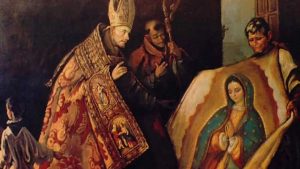Little is known about the life of St. Juan Diego Cuauhtlatoatzin before his conversion, but tradition and archaelogical and iconographical sources, along with the most important and oldest indigenous document on the event of Guadalupe, “El Nican Mopohua” (written in Náhuatl with Latin characters, 1556, by the Indigenous writer Antonio Valeriano), give some information on the life of the saint and the apparitions.
On December 9, 1531, when Juan Diego was on his way to morning Mass, he began to hear strains of beautiful music, and then the Blessed Mother appeared to him on Tepeyac Hill for the first of five occasions. She addressed Juan Diego by name, then dubbing him “el más pequeño de mis hijos,” (translated: the littlest of my children). The Virgin asked Juan Diego to go to the Bishop, Juan de Zumárraga, and to request in her name that a shrine be built at Tepeyac, where she promised to pour out her grace upon those who invoked her. The Bishop, who did not believe Juan Diego, asked for a sign to prove that the apparition was true. On 12 December, Juan Diego returned to Tepeyac. Here, the Blessed Mother told him to climb the hill and to pick the flowers that he would find in bloom. He obeyed, and although it was winter time, he found roses flowering. He gathered the flowers and took them to Our Lady who carefully placed them in his tilma (his mantle), and told him to take them to the Bishop as “proof”. When he opened his tilma, the flowers fell on the ground and there remained impressed, in place of the flowers, an image of the Blessed Mother, the apparition at Tepeyac.
The miraculous image, which is preserved in the Basilica of Our Lady of Guadalupe, shows a woman with native features and dress. She is supported by an angel whose wings are reminiscent of one of the major gods of the traditional religion of that area. The moon is beneath her feet and her blue mantle is covered with gold stars. The black girdle about her waist signifies that she is pregnant. Thus, the image graphically depicts the fact that Christ is to be “born” again among the peoples of the New World, and is a message as relevant to the “New World” today as it was during the lifetime of Juan Diego.
Our Lady of Guadalupe
St. Juan Diego is a saint for garment justice for two main reasons. First, quite literally, his humble garment, the tilma, has powerfully been means of conversion for many people. Secondly, in St. Juan Diego himself we see God working mysteriously, powerfully within those who are most poor. Here in Advent, we are preparing ourselves for Christ’s birth. The Messiah was not born in a palace in a major capital of the world, but the Messiah was born to a poor family in a barn in a backwater province of the Roman Empire. In “El Nican Mopohua,” the Blessed Mother does not present herself to the powerful, politically, economically, or religiously, but instead presents herself to a poor native person. Her face, not European, but dark as a native, invites us to see God’s action and presence in the poor.
We might imagine anew the appearance of Our Lady of Guadalupe, not to the privileged, but to her smallest, most forgotten children, garment workers earning but $4 an hour in Los Angeles, women working in a maquiladora in a free trade zone along the Rio Grande, or to a garment worker in a crowded factory in Bangladesh.
The Rev. David García, former rector of San Fernando Cathedral in San Antonio, Texas, explains the intimate identification between Juan Diego and the Mexican people:
“Juan Diego’s story is our story. His hesitancy is ours in the face of being called to share the Good News and change our world. His feelings of nothingness are reflected in our sense of inadequacy against a society that puts us down at every turn. His call to take the message is our call to tell others that God wants things different, that God loves those who are poor and powerless, that God does not forget the sufferings of God’s people, and that God is with us on our pilgrimage through a hostile world.” (p. 22)
At its heart, this is a joyful, exuberant feast of “flor y canto,” flower and song. Before her first appearance, St. Juan Diego heard beautiful song and gathered miraculous flowers. Let us not once again, like Bishop Juan de Zumárraga five centuries ago, turn away Juan Diego as he approaches us bearing in his tilma the precious gift of God’s great love for us all. As people of faith, let us embrace this feast with joy, heralding St. Juan Diego and Our Lady of Guadalupe as invitations to deepen our solidarity with those who are poor, those who are forgotten.
Prayer to St. Juan Diego
Saint Juan Diego, you are our first American indigenous saint. You who were chosen by Our Lady of Guadalupe as an instrument to show your people and the world that the way of Christianity is one of love, compassion, understanding, appreciation and respect for God’s creation, and, most of all, humility. You who we know is now in the Kingdom of the Lord and close to our Mother, be our angel and protect us, stay with us as we struggle in this modern life not knowing most of the time where to set our priorities. Help us to pray to our God to obtain the gifts of the Holy Spirit and use them for the good of humanity and the good of our Church. And we ask Our Lady, who appeared to you as your Mother and Mother of all in our land, to wrap her mantle of protection around all migrant people. We beg for her love, compassion, help and protection on all immigrants who today experience great sufferings, sorrows, necessities and misfortunes. Amen

